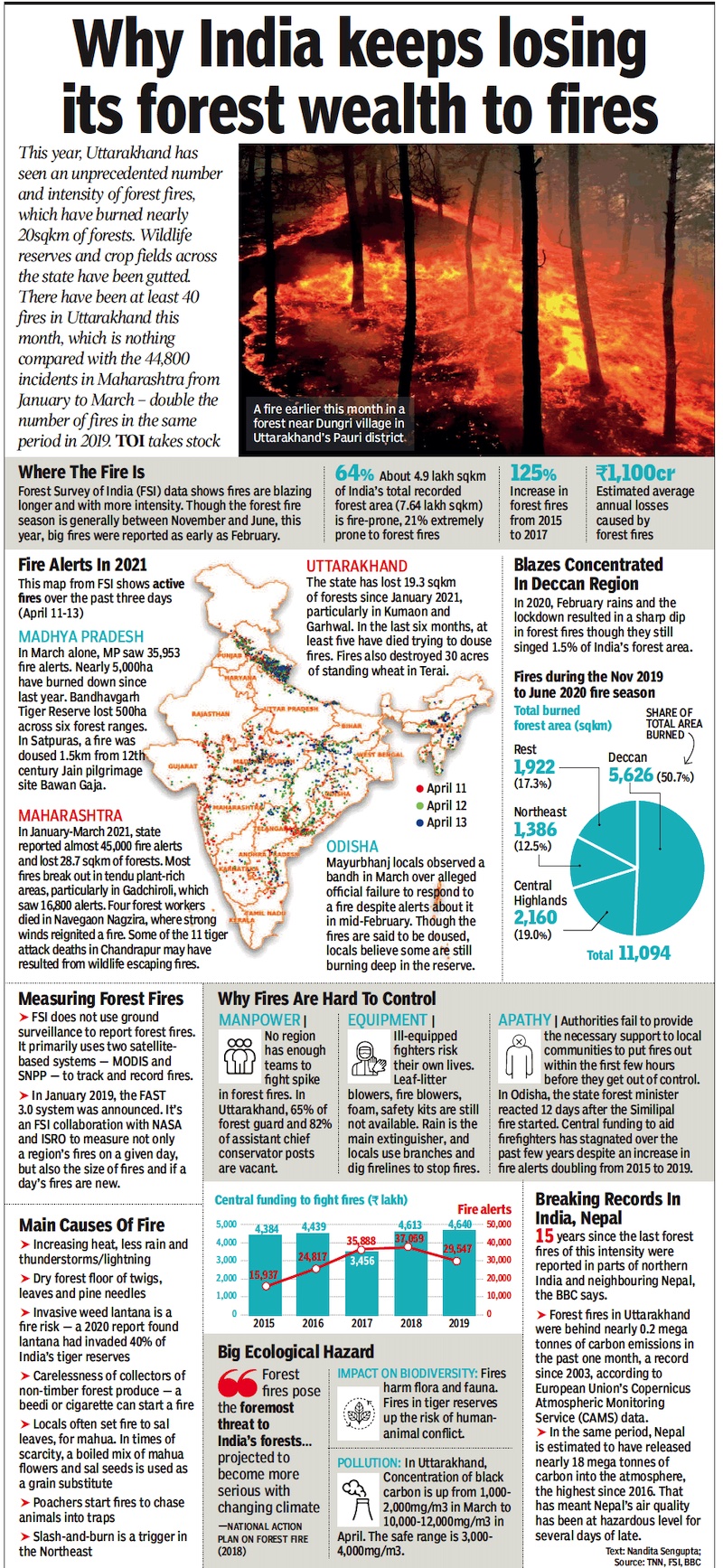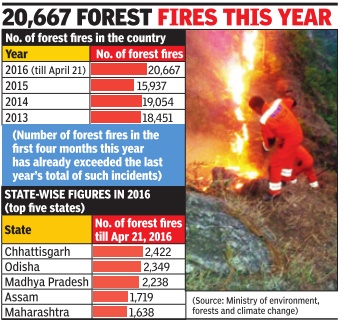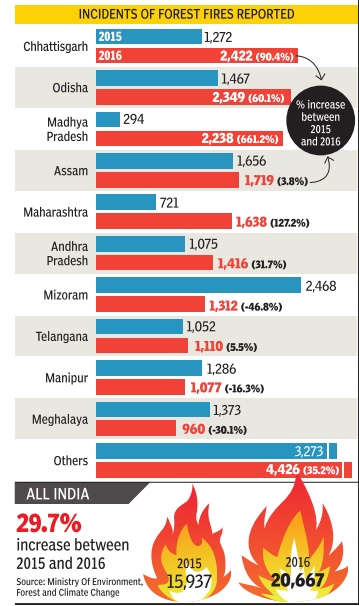Forest fires: India
This is a collection of articles archived for the excellence of their content. |
Contents |
A: ISSUES
2024: The debate on definition continues
Dec 22, 2024: The Times of India
DEHRADUN: The release of Forest Survey of India published ‘India State of Forest Report’, on Saturday, evoked mixed response from experts. Many continued to debate on why the plantation of trees outside forests was not counted as green cover, considering that it is a place that is “habitat to myriad animals and endless microorganism and invisible lives thriving on that ecosystem”.B K Singh, retd principal of chief conservator of forests and head of forest force, Karnataka, said, “We have added 1445 sq km of forest and tree cover in two years. Of this, the increase in forest cover is only 156 sq km, and more interesting is that it is only 7 sq km in recorded forests. Forest and tree cover areas put together are 8,27,357 sq km, where the forest cover is a sizable chunk of 7,15,343 sq km. The increase is quite meagre, as compared to the size. Forest departments have been planting in recorded forests at the rate of 100 sq km annually. Why do these plantations not show an increase in cover?”
He further said that around 7 sq km has been lost in mangroves. “Again, coastal states are planting mangroves, and the report shows a loss in mangroves. Deforestation is continuing all over, and the report has attempted to cover that,” he added.
Environmentalists said that the forest department’s efforts should be assessed and discussed in the biennial report rather than public areas and plantations. Veteran environmentalist Ravi Chopra said, “For quite some time, the ministry has been recording the trees outside of the forest department and the forests in its estimates of the forest cover. It appears from a quick glance of the report that much of the increase has taken place in trees outside of the designated forest area and therefore, it would be incorrect to pat the ministry on its back. For all we know, this may be people’s efforts on tree planting. In fact, if we look at Uttarakhand, there are so many landslides that are taking place that we should be losing forest cover under the forest department. The new plantations ought not to be counted as forest cover until the plants have matured.”
(Inputs from Pankul Sharma)
Forest fires
Causes, incidence, 2019-20

From: April 14, 2021: The Times of India
See graphic:
Forest fires in India, Causes, incidence, 2019-20
Number of forest fires: 2013-16

See graphic, ' Number of forest fires in the country, 2013-April 2016, year-wise… '
Number of forest fires: 2015-16

See graphic, ' Incidents of forest fires reported, 2015-16, state-wise... '
2019-20
Shivani Azad & Ashok Pradhan, March 5, 2021: The Times of India
It has been eight days since a fire broke out in Odisha’s Similipal biosphere reserve, affecting over 300 hectares of forests and home to the Bengal tiger and Asian elephant.
On Thursday, Odisha had the highest number of realtime fire alerts, at 154 locations, out of 650 across the country. It is in keeping with the larger pattern — latest Forest Survey of India (FSI) data accessed by TOI show forest fire alerts shot up across the country by 125% this year. Between November 2019 and January 2020, some 1,321 alerts were sent out. This year, 2,984 warnings were sent.
The highest number of alerts has been sounded in Uttarakhand (470, up from 39), followed by Odisha (353, up from 158) and Maharashtra (324, up from 163). “The numbers are high this year because of the dry season,” deputy director of FSI Sunil Chandra said. The head of forest forces in Himachal Pradesh, Savita, said: “It has been very dry this winter. We barely had any snowfall even in January and February.”
“The unusual shift in fire season seems to be due to either climate change or greater human intervention in forests,” Arti Chaudhary of the Forest Research Institute said. In many states, forest authorities assigned blame to forest dwellers or questioned the data. “It is wrong to say Simlipal is burning. A spike in fire incidences were recorded on March 1 and 2 only,” said Shashi Paul, principal chief conservator of forests (wildlife), under whose jurisdiction Similipal lies.
Paul added: “Since February 15, tribals have been going into the forests to collect mahua and have been lighting fire under the trees.”
2020- 2021 June
Shivani Azad, August 21, 2022: The Times of India
Dehradun:A surge in human activity in and around forests after Covid lockdown restrictions were eased led to an alltime record — 3. 5 lakh — forest fire alerts across India, says Forest Survey of India (FSI) data of the past four years.
A staggering “3,45,989 fire alerts” were sent between November 2020 and June 2021 — a period when Covid restrictions were lifted in many states and human activities surged, soon to be followed by the second wave of the deadly Delta variant. The state of forest fire alert system by FSI was shared by officials a t a recent confer ence by Centre for Ecology Development and Research (CEDAR) on forest fires in Dehradun.
In comparison, during the first wave, between November 2019 and June 2020, 1,24,473 forest fire alerts were recorded. And between November 2021 and June 2022, when the third wave of Covid struck, 2,23,333 fire alerts were recorded, similar to pre-pandemic times — 2,10,286 between November 2018 and Jun e 2019. In fact, winter fires had previously not been reported in Uttarakhand but it occurred during that time, perhaps due to surge in human activity after the end of the first lockdown.
The highest incidences in that duration took place in Odisha (51,968) followed by Mad- hya Pradesh (47,795), Chhattisgarh (38,106), Maharashtra (34,025), Jharkhand (21,713) and Uttarakhand (21,487).
So, what led to the sharp spike in fires during the second wave?
Experts attribute it to various biophysical reasons, including the restrictions imposed on forests during Covid first wave when strict lockdown was enforced. Spike in tourism and other economic activities are also among the main reasons.
“Movementof people inside forests was completely restricted after a natio nwide lockdown in the last week of March 2020. However, when restrictions were eased, it led to a sudden invasion of people into forests, setting stage for forest fires as the forest floor was full of dry leaves that are otherwise cleared by villagers for fodder or by forest department,” said senior ecologist SP Singh.
Interestingly, a study (Co- vid lockdown a window of opportunity to understand the role of human activity on forest fire incidences in western Himalayas) about the relationship between forest fires and anthropogenic pressure by IIT-Bombay and IIRS scientists during the lockdown period from March to May 2020 stated that “70% of the forest fires are directly related to tourism and other economic activities,” said Arijit Roy, senior scientist (IIRS Dehradu n) and co-author of the study at the conference.
Vishal Singh, director (research) of CEDAR, added, “Most of these fires are happening near roadsides which itself is indicative that these are inten tional fires, which are always more devastating than controlled ones. After the first wave of Covid, there was a sharp increase in tourism, and people were keen to venture out. And most of the time irresponsible tourism triggers such fires. ”
2021> 2024
Dec 22, 2024: The Times of India
Dehradun : The latest ‘India State of Forest Report (ISFR)’, released by Forest Survey of India (FSI), points out that various measures — such as the use of technology and advanced training of field staff — carried out to manage wildfires, have resulted in a decrease in blaze cases, reports Shivani Azad.
The ISFR report pointed out that “during the fire season 2023-24, the number of fire hotspots detected by sensors was 2,03,544, as against 2,23,333 in 2021-22 and 2,12,249 in 2022-23, thereby showing a declining trend.” Highlighting the global scenario, the report stated: “From 2001 to 2022, there was a total of 126 million hectares (mha) tree cover loss from fires globally and 33 mha from other drivers of loss. The year with the most tree cover loss due to fires during this period was 2016, with 9.6 mha lost to fires — 32% of all tree cover loss for that year. From 2001 to 2022, Russia had the highest rate of tree cover loss due to fires, with an average of 2.5 mha lost per year, followed by Canada (1.2 mha) and the US (566 kha).”
It stated, “The top three states where fire incidences were observed the most in 2023-24 forest fire season were Uttarakhand (21,033), Odisha (20,973) and Chhattisgarh (18,950).” These were followed by Andhra Pradesh (18,174), Maharashtra (16,008), Madhya Pradesh (15,878), Telangana (13,479), Himachal Pradesh (10,136), Assam (7,639) and Jharkhand (7,525).
Union environment minister Bhupender Yadav, at the report release event in Dehradun, expressed his concern regarding forest fires in the country. He said, “We are constantly working towards combating wildfires by employing local communities, technology and all possible methods for keeping our forest in the best form.”
FSI director, Anoop Singh, added, “Response rate of forest teams in dousing wildfires inside the protected areas of the country has been found to be praiseworthy, according to the data analysed.” FSI conducted an analysis of forest fires in 705 protected areas of the country and found that as many as 6,046 cases were detected in national parks this season.
B: STATE-WISE
Goa
2023
Gauree Malkarnekar, March 13, 2023: The Times of India
PANAJI: Goa’s forest fires, which have been raging for nine days now, have left behind atrail of destruction, scorching endemic trees, birds and reptiles in the Western Ghats, one of the eight biodiversity hotspots of the world. Evergreen patches and the ecological cycle which had evolved over hundreds of years have been reduced to ashes, said onground volunteers who are assisting the state administration in dousing the blaze.
“I saw a tree, at least 100 years old, coming down right in front of my eyes. It is wrong to say ground fires cannot cause damage to flora and fauna because most fires start as ground fires only,” said conservationist Chandrakant Shinde, who witnessed the fires first-hand — both at the Mhadei Wildlife Sanctuary at Sattari and at the Bhagwan Mahaveer Wildlife Sanctuaryat Mollem. Shinde said if there is damage to the roots, there was no way the trees would survive. “Volunteers have dug pits around trees wherever we could to save them,” he added.
On Saturday, the Union environment ministry — based on the detailed report provided by Goa officials — had said the forest fires do not appear to have caused major flora and faunal damage.
‘Won’t see birds nesting in these patches next year’
Shinde said if there is damage to the roots, there was no way the trees would survive. “Volunteers have dug pits around trees wherever we could to save them,” he said.
“I saw burnt down permanent nests of woodpeckers on the ground, along with dead vipers, geckos, centipedes, millipedes. An unaccountable number of lesser fauna has been burnt to ashes. You will not see birds nesting in these patches next year at all,” Shinde said.
Another volunteer questioned how the conclusion of no major damage to flora and fauna was reached when the fires are still raging.
“When was a full-fledged conclusive assessment done, because all forest staffers are still involved in the dousing exercise,” said the volunteer.
The volunteers also expressed doubts about whether routine preventive measures were taken in preparation of the approaching summer.
“Fire lines have to be created in the winter itself in preparation of summer. Fire lines are burning of forest litter in isolation to create lines so that, if there is afire, the burning does not spread from one compartment to another,” said the volunteer.
He said the fire line ensures that the supply of fuel, which is dry leaves, is cut off at the fire line. “But we saw forest staff creating fire lines now, after the fires had already done the damage,” said the volunteer.
Alex Carpenter, a conservationist, who has been working in Goa’s protected areas for the past eight years and is presently volunteering to douse the fire at Satrem and Derodem inside Mhadei Wildlife Sanctuary,said that hundreds, if not thousands, of trees have perished in the fire already.
“The fires in Mhadei’s forest have had a huge impact on flora and fauna within the sanctuary. There are many examples of living evergreen trees that have burnt and perished, including trees of huge size and which are hundreds of years old. Fire is not a natural occurrence in evergreen and semi evergreen forests of the Western Ghats and some trees contain high resin quantities, which allows them to set alight if there is a small fire,” Carpenter said.